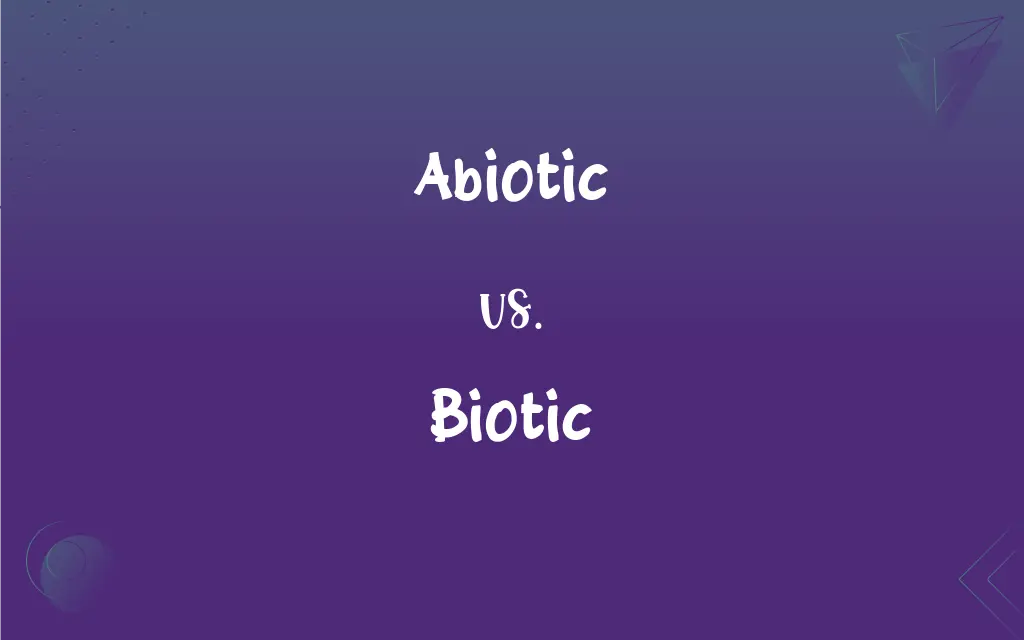Abiotic vs. Biotic: What's the Difference?
Edited by Janet White || By Harlon Moss || Updated on October 10, 2023
Biotic factors are living or once-living organisms in an ecosystem, while abiotic factors are non-living physical and chemical elements in an ecosystem.

Key Differences
Abiotic and biotic factors are foundational components that build the ecosystems of our planet, constituting the living and non-living elements, respectively. Abiotic factors, intrinsically non-living, pertain to the physical and chemical components of an environment, such as sunlight, temperature, and soil composition. Biotic factors, in contrast, envelop all the living or once-living organisms within an ecosystem, like plants, animals, and microorganisms. Both of these elements, abiotic and biotic, interact consistently, shaping the dynamics and sustainability of ecosystems.
Considering a terrestrial ecosystem, abiotic factors like sunlight, rainfall, and temperature become pivotal in determining the flora and fauna that inhabit it. On the other hand, the biotic factors involve the vegetation, animal life, and any other living organisms contributing to ecological processes. Abiotic factors inherently shape the environment, guiding the distribution and behavior of the biotic elements within, essentially providing a platform upon which living organisms survive, interact, and evolve.
When we gaze upon an aquatic ecosystem, we witness another rich interaction between abiotic and biotic factors. The abiotic components, including water salinity, pH levels, and light penetration, determine the kind of biotic life that can flourish within those watery bounds. Concurrently, the biotic components, such as fish, algae, and bacteria, play a significant role in maintaining the ecological balance and influencing the physical and chemical properties of the aquatic environment, showcasing an intricate reciprocity between the biotic and abiotic.
Examining an arid desert landscape, the dominant abiotic factors, such as sparse rainfall, high temperatures, and sandy soils, starkly influence the biotic presence. The biotic factors, such as cacti, reptiles, and specific mammal species, adapt to survive under these abiotic conditions, developing unique features and behaviors that enable them to navigate the harshness of the environment. Thus, the relationship between abiotic and biotic factors intricately weaves the tapestry of life and survival across varied ecosystems.
Comparison Chart
Definition
Non-living elements
Living or once-living organisms
ADVERTISEMENT
Examples
Sunlight, water, temperature
Plants, animals, fungi
Interaction with Life
Influences living organisms
Interacts and coexists with other living organisms
Role in Ecosystem
Determines conditions for life
Contributes to life and organic activities
Contribution to Life
Does not reproduce or die
Capable of reproduction and death
Abiotic and Biotic Definitions
Abiotic
Abiotic factors refer to the non-living physical and chemical components in an ecosystem that influence living organisms.
The high salt content in ocean water is an abiotic factor that affects the organisms able to live there.
ADVERTISEMENT
Biotic
Biotic factors encompass all life forms, such as flora, fauna, fungi, and bacteria, interacting within an ecological community.
Coral reefs are vibrant ecosystems with a plethora of biotic interactions among various marine species.
Abiotic
Abiotic elements can dictate the availability and usability of resources within an ecological context.
Abiotic factors like poor soil quality can hinder plant growth and subsequently affect the entire food chain.
Biotic
Biotic interactions describe the relationships and interplay between living organisms within an environment.
Mutualistic biotic interactions are seen between bees, which gather nectar, and flowers, which get pollinated.
Abiotic
Abiotic aspects of an environment shape and restrict the ecosystems and biotic life that can exist there.
Extreme abiotic conditions, such as high-altitude or deep-sea environments, host specific, adapted biotic life.
Biotic
Biotic components involve all entities in an environment that are capable of reproduction and death.
A biotic factor like predator presence can significantly shape the population dynamics of prey species.
Abiotic
Abiotic is utilized to describe conditions, factors, or attributes that are absent of life or living organisms.
Rocks and minerals, crucial for various ecological processes, are considered abiotic elements within an environment.
Biotic
Biotic resources are derived from living organisms and may include material like wood, leather, and foods.
Humans utilize a variety of biotic resources, such as crops and animals, to sustain themselves and develop societies.
Abiotic
Abiotic stress pertains to pressure exerted on organisms due to non-living factors in their environment.
Drought, an abiotic stress, significantly impacts agricultural yield, affecting both plants and reliant species.
Biotic
Biotic refers to living organisms and factors within an ecosystem or environment.
The lush forest is brimming with biotic life, from towering trees to tiny insects.
Abiotic
Nonliving
The abiotic factors of the environment include light, temperature, and atmospheric gases.
Biotic
Of or having to do with life or living organisms.
Abiotic
Nonliving, inanimate, characterised by the absence of life; of inorganic matter.
Biotic
Produced or caused by living organisms.
Abiotic
Tending to inhibit or destroy life; antibiotic; incompatible with life.
Biotic
(biology) Of, pertaining to, or produced by life or living organisms
Abiotic
Any such material
Biotic
Misspelling of biontic
Biotic
A nutritional substance that improves the health of gastrointestinal microorganisms, especially one that occurs naturally.
Biotic
A simple organic organism that is more complex than an organic molecule but simpler than a plant or animal.
Biotic
Relating to life; as, the biotic principle.
Biotic
Produced by or caused by living things.
Biotic
Of or relating to living organisms
FAQs
Can abiotic elements influence biotic components?
Absolutely, abiotic elements like sunlight and water availability directly influence the presence and health of biotic components.
What is a biotic stress?
Biotic stress involves pressure or damage caused to organisms by other living organisms, such as pests, diseases, or predators.
What is meant by abiotic?
Abiotic denotes the non-living physical and chemical aspects of an ecosystem.
Can biotic factors affect abiotic factors?
Yes, biotic factors like plants and animals can influence abiotic factors, such as nutrient content and soil structure.
What role do abiotic factors play in defining biomes?
Abiotic factors, such as climate and soil type, play a pivotal role in defining biomes by establishing the conditions under which specific biotic life can exist.
What constitutes abiotic stress?
Abiotic stress pertains to challenges posed by non-living factors like drought, salinity, and extreme temperatures.
Is weather an abiotic factor?
Yes, weather, being a non-living condition, is considered an abiotic factor.
Can abiotic and biotic factors impact ecosystem stability?
Yes, both abiotic and biotic factors play crucial roles in maintaining ecological balance and stability.
Are viruses considered biotic or abiotic?
This is debated; viruses are often categorized as abiotic as they are non-living outside host cells, but some argue for a biotic classification due to their interaction with living cells.
Is soil considered an abiotic factor?
Yes, soil is generally considered abiotic, although it can contain biotic components like microorganisms and organic matter.
Can the biotic component of an ecosystem alter its abiotic component?
Certainly, biotic components, through activities like decomposition, can alter abiotic elements, such as nutrient availability.
Can biotic interactions influence ecosystem services?
Yes, biotic interactions, such as pollination and decomposition, significantly contribute to ecosystem services beneficial to other organisms, including humans.
Are humans considered biotic factors?
Yes, humans are considered biotic factors as they are living organisms.
Can changes in abiotic factors impact biotic populations?
Yes, alterations in abiotic factors, such as temperature, can significantly impact biotic populations by affecting habitats and resources.
How is the biotic component of an ecosystem categorized?
Biotic components are often categorized into producers, consumers, and decomposers based on their ecological roles.
Can an entity be both biotic and abiotic?
Generally, entities are categorized as either biotic or abiotic, but some, like viruses, can blur these lines due to their unique characteristics.
What does biotic mean?
Biotic refers to everything that is living or was once living in an environment.
How do biotic factors interact among themselves?
Biotic factors interact through various relationships, such as predation, competition, and symbiosis, influencing each other’s presence and abundance.
How do abiotic factors affect an organism's adaptation?
Abiotic factors define the environmental conditions to which organisms must adapt to survive and reproduce effectively.
How does the biotic environment influence an organism’s evolution?
The biotic environment, through interactions and selective pressures, can shape an organism's evolution by favoring advantageous traits.
About Author
Written by
Harlon MossHarlon is a seasoned quality moderator and accomplished content writer for Difference Wiki. An alumnus of the prestigious University of California, he earned his degree in Computer Science. Leveraging his academic background, Harlon brings a meticulous and informed perspective to his work, ensuring content accuracy and excellence.
Edited by
Janet WhiteJanet White has been an esteemed writer and blogger for Difference Wiki. Holding a Master's degree in Science and Medical Journalism from the prestigious Boston University, she has consistently demonstrated her expertise and passion for her field. When she's not immersed in her work, Janet relishes her time exercising, delving into a good book, and cherishing moments with friends and family.































































